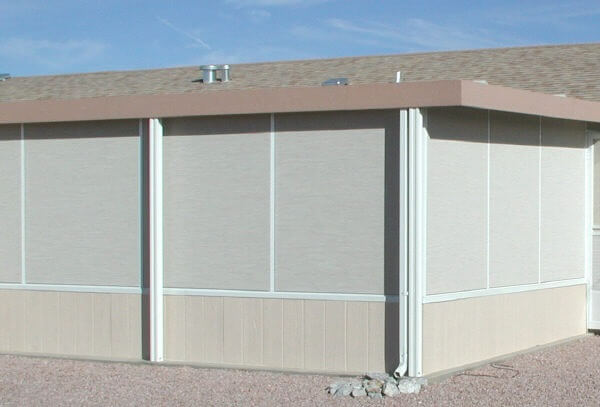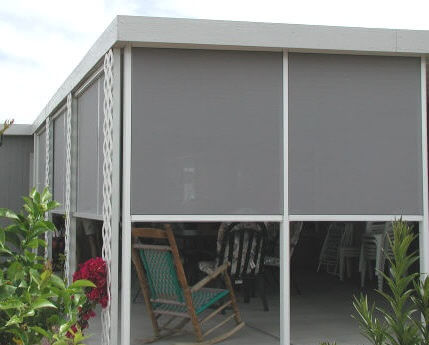Shade Screen Material
The Right Screen For Your Shade Structures
Shade screen material comes in many colors and styles. Words like 70% sun block or 80% sun block are used a lot. All screens have their own sun reflective properties. Shade screen can be made for exterior use or interior use.
There is a difference between shade screens and solar screens, although they serve similar purposes, which is to help control the amount of sunlight that enters a window.Shade screens, also known as privacy screens, are typically designed to provide privacy and to decrease glare from sunlight. They can reduce solar heat gain, but not as efficiently as solar screens. They are usually made of lighter weight materials and are more decorative.
Solar screens, on the other hand, are specifically designed to block a significant portion of solar heat and UV rays, which helps to save energy and protect the interior furnishings from sun damage. They are denser and darker than shade screens. They also offer some privacy benefits, but their main function is energy efficiency. A high-quality solar screen can block 70-90% of solar heat.
In general, the decision between solar screens and shade screens depends on the specific needs and priorities of the user.
Solar Screen![]() (#ad)
(#ad)

The screen in this photo is 80% Phifer Suntex. It has great solar properties and very good outward visibility. Click here to see screen prices.
Visit our solar screen page to learn more about shade screen material. When using shade screen with a wood frame the screen should be stretched tight and stapled in place. An outer wood frame can be nailed to the outside for decoration and to help hold the screen. Use screen spline to attach shade screen to a screen room framing. Spline comes in many different sizes so be sure the size matches your frame and screen. Screen material rolled into a separate screen frame is also attached with spline. These screen frames are my favorite ways of using shade screen.

You may want to consider these mounting options.
- Inside Mount: In this method, the screen is mounted inside the window frame. It's the most common method used for mounting window screens because it provides a clean, built-in look.
- Outside Mount: This method involves mounting the screen on the outside of the window frame or on the wall around the window. It's generally used when the window isn't deep enough for an inside mount.
- Channel Mount: Some screens are designed to slide into channels on the sides of the window frame. This is common for certain types of solar screens.
- Casement Clip Mount: This method involves using clips to secure the screen to a casement window. It's common for windows that crank open.
- Velcro Mount: For some types of screens, Velcro can be used to attach the screen to the window frame. This allows for easy removal and reattachment.
- Magnet Mount: In this method, magnetic strips are used to attach the screen to a metal window frame.
- Tension Rod Mount: This method uses a tension rod to hold the screen in place inside the window frame.
The method of mounting depends on the type of window, the design of the screen, and the preferences of the homeowner. Regardless of the method, it's crucial to ensure that the screen is securely attached and fits properly to provide maximum effectiveness and durability.
When shopping for solar screens consider there brands.
Phifer - Phifer's 'SunScreen' and 'SunTex' lines are particularly known for solar screening.
Solar Screen Outlet - Offers custom solutions and DIY kits.
DocaScreen - Known for its durability and quality.
The Solar Screen Factory - Specializes in affordable solar screens.
If you are leaning more for a shade screen consider these options.
Coolaroo - Known for their 'Outdoor Cordless Roller Shade' screens.
Radiance - Offers a range of solar shades for windows.
Bali - Noted for their custom fabric shades.
Levolor - Offers a variety of shades, including solar shades.
Phantom Screens - Known for their retractable screens that offer shade and privacy.
Please note that while these brands have many types of screens available, you should focus on those specifically labeled as "solar screens" or "shade screens" or have similar functions for the best results. Always choose the one suitable for your specific window sizes and sunlight control needs.